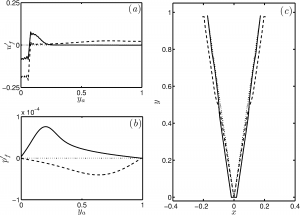Non-normality & internal flame dynamics in premixed flame-acoustic interaction
Subramanian, P. & Sujith, R.I.

Abstract:
This paper investigates the non-normal nature of premixed flame–acoustic interaction. The thermoacoustic system is modelled using the acoustic equations for momentum and energy, together with the equation for the evolution of the flame front obtained from the kinematic G-equation. As the unsteady heat addition acts as a volumetric source, the flame front is modelled as a distribution of monopole sources. Evolutions of the system are characterized with a measure of energy due to fluctuations. In addition to the acoustic energy, the energy due to fluctuations considered in the present paper accounts for the energy of the monopole sources. The linearized operator for this thermoacoustic system is non-normal, leading to non-orthogonality of its eigenvectors. Non-orthogonal eigenvectors can cause transient growth even when all the eigenvectors are decaying. Therefore, classical linear stability theory cannot predict the finite-time transient growth observed in non-normal systems. In
the present model, the state space variables include the monopole source strengths in addition to the acoustic variables. Inclusion of these variables in the state space is essential to account for the transient growth due to non-normality. A parametric study of the variation in transient growth due to change in parameters such as flame location and flame angle is performed. In addition to projections along the acoustic variables of velocity and pressure, the optimal initial condition for the self-evolving system has significant projections along the strength of the monopole distribution. Comparison of linear and corresponding nonlinear evolutions highlights the role of transient growth in subcritical transition to instability. The notion of phase between acoustic pressure and heat release rate as an indicator of stability is examined.
Publication details: Journal of Fluid Mechanics, vol. 679, pg. 315-342, 2011.
PDF Journal Google Scholar metrics
